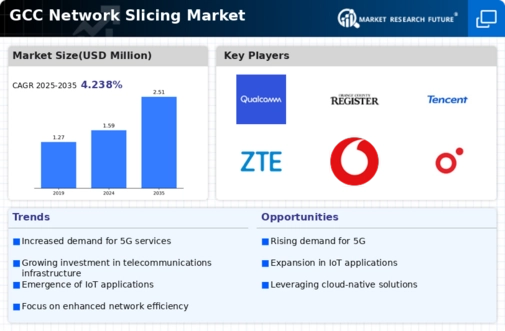The GCC Network Slicing Market presents a dynamic landscape characterized by the competition among various technology providers and telecom operators aiming to revolutionize connectivity through tailored service delivery. As digital transformation accelerates, the demand for network slicing grows, allowing operators to cater to diverse applications ranging from IoT to enhanced mobile broadband for both consumer and enterprise segments. With the enhancement of 5G technologies, network slicing is becoming a focal point for operators seeking to optimize their network resources while providing customized services to their subscribers.
Market participants are engaged in innovating their offerings, enhancing customer experiences, and leveraging next-generation infrastructure, leading to a highly competitive environment in the GCC region.Qualcomm has established a significant foothold in the GCC Network Slicing Market, driven by its advanced technologies that underpin 5G network capabilities. The company’s strong research and development capabilities have led to the creation of robust network solutions tailored for efficient service delivery through slicing.
Qualcomm’s strengths lie in its comprehensive semiconductor solutions, which are integral to the seamless implementation of 5G networks. By integrating its innovative products into network infrastructure, Qualcomm enables operators to efficiently manage network resources, enhance performance, and cater to varying demands. Moreover, through strategic partnerships with local telecom companies and device manufacturers, Qualcomm has positioned itself as a key player in facilitating the adoption of network slicing, ensuring its technology's strong presence throughout the GCC region.
Orange has actively engaged in the GCC Network Slicing Market, leveraging its extensive experience in telecom services to enter new growth avenues. The company offers a range of products and services focused on 5G network slicing, enabling operators to define and manage diverse service levels across various use cases efficiently. Orange's strengths in the region include its established relationships with key partners, innovative approaches to digital transformation, and a commitment to enhancing customer experiences.
The company has made strategic alliances and has engaged in mergers and acquisitions to broaden its market reach and optimize its service offerings for the GCC landscape. By reinforcing its capabilities in network slicing, Orange continues to contribute to the development of customized solutions that meet the specific needs of enterprises and consumers, thus reinforcing its competitive position within the fast-evolving telecommunications market in the GCC.

























Leave a Comment